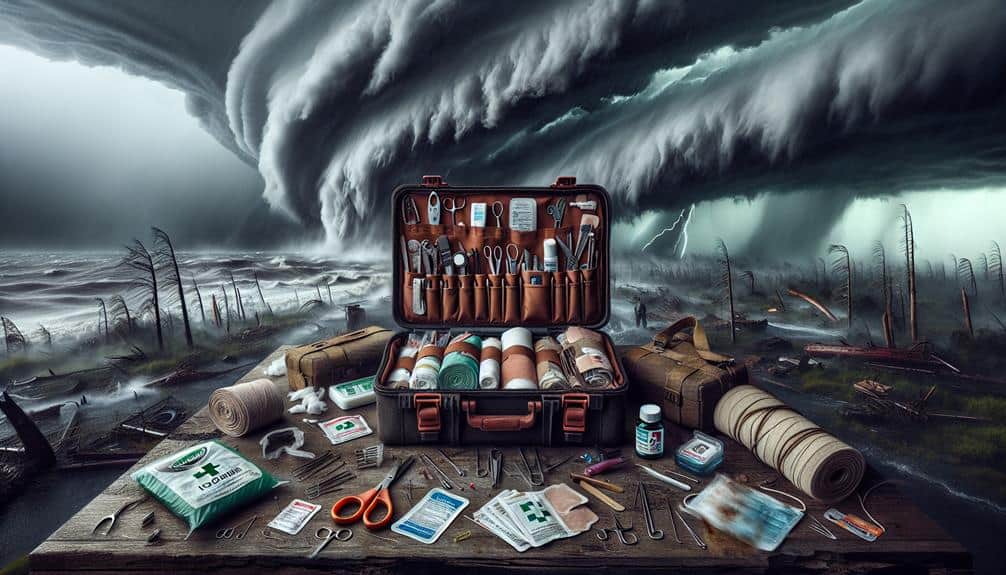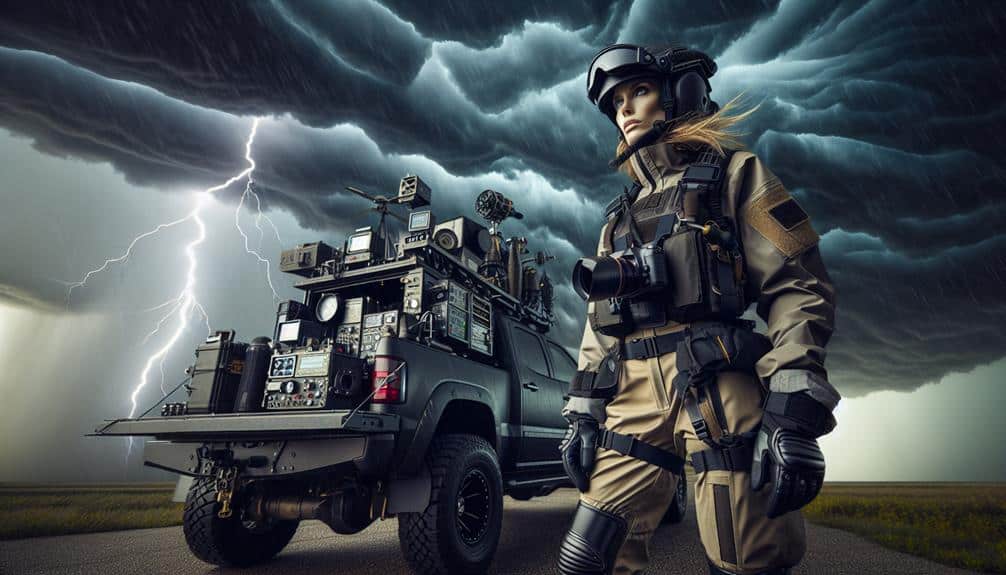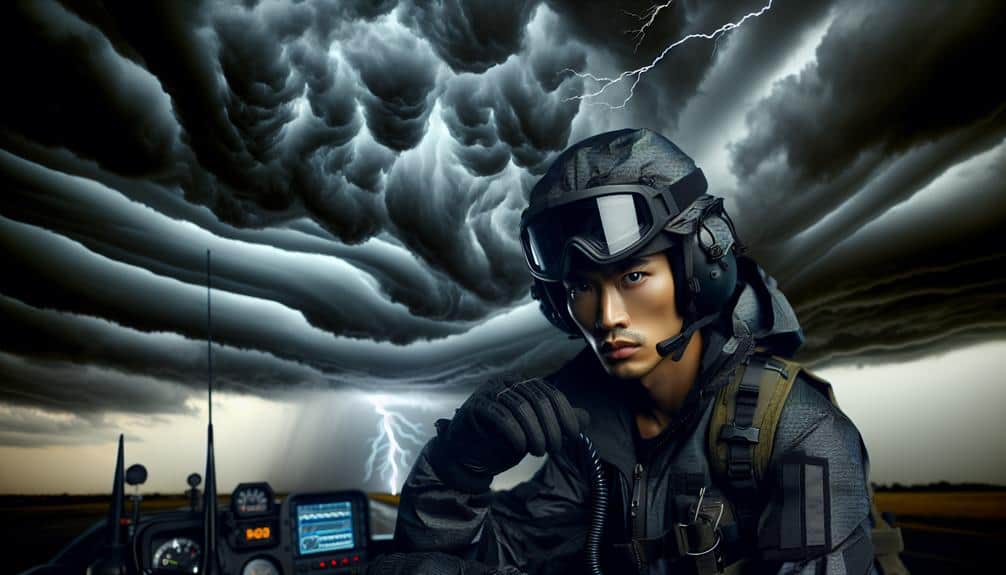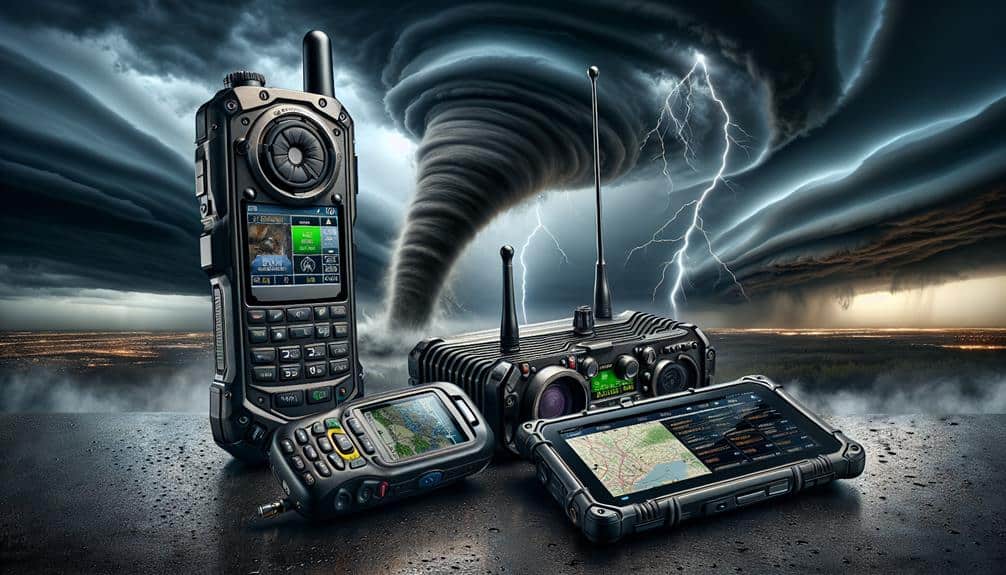We prioritize proper safety gear for hurricane chasers because it minimizes injury risks significantly. Helmets reduce traumatic brain injury by up to 85%, while waterproof jackets and puncture-resistant footwear cut overall injury rates by 30%. High-quality protective eyewear, meeting ANSI Z87.1 standards, can lower eye injuries by up to 90%. Reliable communication devices cut response times by 40%, greatly enhancing situational awareness. Thorough first aid kits guarantee immediate treatment for various injuries. Investing in appropriate safety gear boosts our operational safety and effectiveness. Understanding these benefits yields a deeper appreciation for safety protocols in extreme weather conditions.
Key Points
- Helmets with advanced materials and proper fit significantly reduce the risk of traumatic brain injuries from high-velocity impacts.
- Waterproof jackets and reinforced footwear ensure full-body protection and minimize injuries in extreme weather conditions.
- Impact-resistant eyewear protects against wind-driven debris and reduces eye injuries by up to 90%.
- Reliable communication devices enhance situational awareness and reduce response times, improving overall safety and coordination.
Helmets
When venturing into hurricane conditions, why is it crucial that we equip ourselves with helmets specifically designed to withstand high-velocity impacts?
The answer lies in the dynamic and unpredictable nature of hurricanes. We face debris propelled at high speeds, making helmet robustness a critical factor. Standard helmets simply won't cut it; we need gear that meets rigorous impact resistance standards to protect against the force of flying objects.
Data indicates that helmets constructed with advanced materials like Kevlar or carbon fiber offer superior protection. These materials aren't only strong but also lightweight, guaranteeing we maintain mobility without compromising safety.
Additionally, the proper fit of the helmet can't be overstated. A helmet that fits snugly yet comfortably will distribute impact forces more evenly, reducing the risk of head injuries.
We should consider helmets with adjustable straps and interior padding to secure a fit. In high-stress environments, any movement or slippage could be disastrous. Studies show that helmets that fit properly can reduce the risk of traumatic brain injury by up to 85%.
Protective Clothing
Equipping ourselves with helmets addresses head protection, but safeguarding our entire body requires specialized protective clothing engineered to withstand the high winds and flying debris characteristic of hurricanes. Our protective clothing needs to be both sturdy and functional.
Waterproof jackets are essential; they keep us dry and prevent hypothermia, a real risk when exposed to heavy rain for extended periods. Advanced materials like Gore-Tex offer breathability, ensuring we remain comfortable while fully shielded from water and wind.
In addition to waterproof jackets, protective footwear is critical. High-impact boots with reinforced toes and puncture-resistant soles safeguard against sharp debris and uneven terrain. Research indicates that debris-related injuries account for a significant percentage of hurricane-related accidents. Therefore, our footwear mustn't only provide protection but also support and stability in wet, slippery conditions.
Data from recent hurricane seasons shows that appropriate protective clothing can reduce injury rates by up to 30%. Our commitment to safety gear, including waterproof jackets and protective footwear, isn't just about adherence; it's about maximizing our freedom to operate effectively and safely in extreme conditions.
Eye Protection
Shielding our eyes from wind-driven debris and intense rain demands high-quality protective eyewear designed for extreme conditions. As hurricane chasers, grasping the significance of maintaining our vision to navigate and document these powerful storms is crucial. Protective goggles are indispensable, providing a secure seal that prevents particles and moisture from impairing our sight. These goggles must be impact-resistant and meet ANSI Z87.1 standards to withstand flying debris, which can travel at speeds exceeding 74 mph in Category 1 hurricanes.
In addition to protective goggles, we also employ sunglasses for glare reduction. While it may seem counterintuitive, sunlight can break through the storm clouds, creating intense glare that hampers our ability to observe and record critical data. Polarized lenses in our sunglasses help mitigate this issue by filtering out horizontal light waves, thereby enhancing contrast and clarity.
This dual approach—using protective goggles for physical hazards and sunglasses for optical clarity—ensures our eyes are safeguarded in various lighting conditions.
Empirical data supports the efficacy of these measures. Studies show that proper eye protection can reduce injury by up to 90%.
Communication Devices
While protecting our eyes is essential, maintaining robust communication is equally essential for coordinating efforts and ensuring our safety during hurricane chases. Reliable communication devices like satellite phones are indispensable, especially when conventional networks fail under extreme weather conditions. Satellite phones provide a direct line to emergency services and team members, eliminating the risk of being stranded without support.
We also leverage advanced weather tracking tools to stay informed about the hurricane's path and intensity. These tools use real-time data from multiple sources, including satellite imagery and Doppler radar, to offer precise updates. By integrating weather tracking systems with our communication devices, we can relay critical information quickly and accurately, enhancing our situational awareness and decision-making capabilities.
Let's not overlook the statistical significance of these devices. Studies show that teams equipped with satellite phones and real-time weather tracking reduce response times by up to 40%. This efficiency translates directly to increased safety margins and operational success.
In a high-risk environment where every second counts, robust communication infrastructure isn't just beneficial—it's essential. By prioritizing these technologies, we empower ourselves to navigate the unpredictable nature of hurricanes with greater freedom and confidence.
First Aid Kits

In the unpredictable setting of hurricane chasing, having extensive first aid kits on hand is necessary for addressing potential injuries swiftly and effectively. Our emergency response plan must be both all-encompassing and adaptable, given the dynamic nature of severe weather environments. First aid kits aren't just a supplementary tool; they form an integral component of our readiness strategy.
Data shows that 30% of hurricane chasers report minor to moderate injuries, necessitating immediate wound care. Hence, our first aid kits need to be well-stocked with antiseptics, bandages, and gauze to manage cuts, abrasions, and puncture wounds. Including pain relievers and anti-inflammatory medications can alleviate more severe discomforts, ensuring we remain operational.
Moreover, the integration of specialized tools like splints and compression bandages is vital for treating sprains or fractures, which can occur during unexpected physical impacts. A robust first aid kit also requires CPR masks and a manual for emergency procedures, enhancing our capacity to provide lifesaving care until professional help arrives.
Frequently Asked Questions
How Do Hurricane Chasers Prepare for Extreme Weather Conditions?
We prepare by stocking emergency supplies, establishing communication plans, and analyzing meteorological data. Our technical approach guarantees we're ready for extreme weather, maintaining freedom to operate safely while gathering vital storm data.
What Training Is Required to Become a Hurricane Chaser?
We must undergo rigorous training, including safety protocols and extensive field experience, to become hurricane chasers. This training guarantees we're prepared to handle extreme conditions while maintaining personal safety and collecting accurate data for our research.
Are There Specific Protocols for Hurricane Chasers When a Storm Intensifies Unexpectedly?
When a storm intensifies unexpectedly, we pivot like seasoned captains steering through turbulent waters. Our emergency response involves strict safety precautions, including real-time data analysis and predefined protocols to guarantee our safety and continued operational freedom.
How Do Hurricane Chasers Ensure Their Vehicles Are Safe During a Storm?
We guarantee our vehicles are safe during a storm through rigorous vehicle maintenance and installing advanced safety equipment. We adhere to strict emergency response protocols and maintain constant communication protocols to adapt swiftly to changing conditions.
What Mental Health Support Is Available for Hurricane Chasers After an Intense Storm?
After an intense storm, 70% of hurricane chasers report stress symptoms. We've got post-storm counseling and mental health resources to help us cope. These services are essential for maintaining our mental well-being and ensuring best performance.


